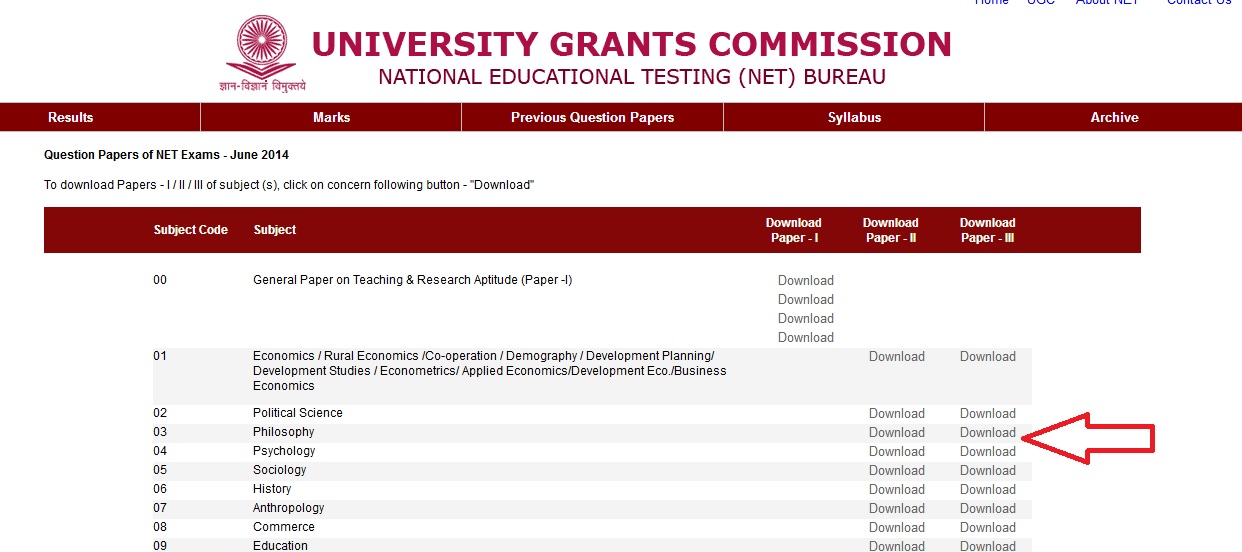ugcnetonline.in NET Folk Literature Model Question Paper : University Grants Commission
Name of the Organization : University Grants Commission
Type of the Exam : UGC National Eligibility Test NET
Subject : Folk Literature
Year : 2014
Document Type : Model Question Paper
Website : http://www.ugcnetonline.in/question_papers_june2014.php
Download Model Question Paper :
Paper – II : https://www.pdfquestion.in/uploads/12992-FolklitII.pdf
Paper – III : https://www.pdfquestion.in/uploads/12992-FolklitIII.pdf
NET Folk Literature Model Question Paper
Download Question Paper of UGC National Eligibility Test NET Folk Literature Sample Question Paper is now available in the official website of University Grants Commission.
Related : University Grants Commission NET Tribal & Regional Language/Literature Model Question Paper : www.pdfquestion.in/12988.html
Instructions
** This paper contains fifty (50) objective type questions of two (2) marks each.
** All questions are compulsory

Model Questions
1. Folklore is precisely
(A) Verbal expressions
(B) Expressive traditions
(C) Material Culture
(D) Popular beliefs
2. What is considered to be the root of society ?
(A) Cultural geography
(B) Cultural anthropology
(C) Folk-cultural background
(D) Folk technology
3. The traditional, unofficial, noninstitutional part of culture is
(A) Literature
(B) Folklore
(C) Poetry
(D) Drama
4. Folklore is “essentially of the people, by the people and for the people” stated by
(A) Theodor H. Gaster
(B) Robert A. Georges
(C) William R. Bascom
(D) George M. Foster
5. The concept of Cultural Hegemony is propounded by
(A) Raymond Williams
(B) Barry Toelken
(C) Antonio Gramsci
(D) Archer Taylor
6. Popular culture means
(A) Non-literature and oral culture
(B) Proletariat and working class culture
(C) Folk and rural culture
(D) Culture cutting across the sections of the populace
7. The concept of ‘Collective Consciousness’ is associated with
(A) Sigmund Freud
(B) Emile Durkheim
(C) Carl Jung
(D) Max Weber
8. ‘Oral exegesis’ is part of
(A) Mythopoeics
(B) Semiotics
(C) Hermeneutics
(D) Phonetics
9. Proverb is made up of
(A) Dialogue having form and content
(B) Description having a topic and a comment
(C) Debate having explorative experience
(D) Depiction of life narrative
10. Structural-morphological study deals with
(A) the distinctive features of each genre
(B) the “functions” of a folktale
(C) texture and structure of the text
(D) All the above
11. Victor Turner observed certain eruptions of social conflicts tended to recur in a particular patterned way, and they are termed as
(A) Social dramas
(B) Rites of passages
(C) Redressive actions
(D) Ritual integration
12. Tongue-Twisting tales are also known as
I. Chain tales
II. Tall Tales
III. Magic tales
IV. Formula tales
Codes :
(A) I, II and III are correct.
(B) II and IV are correct.
(C) II and III are correct.
(D) I and IV are correct.
13. The Oral formulaic characters
I. Should have an element of repetition
II. Should have a written source
III. Should have an element of novelty
IV. Should have a tradition
Codes :
(A) I and II are correct.
(B) III and IV are correct.
(C) I and IV are correct.
(D) All are correct.
14. According to Propp all fairy tales embody the following basic principles :
I. Functions of characters serve as stable, constant elements in a tale.
II. The number of functions known to the fairy tale is limited
III. The sequence of functions is always identical.
IV. All fairy tales are of one type in regard to their structure.
Codes :
(A) I and II are correct.
(B) II and III are correct.
(C) I and IV are correct.
(D) All are correct.
15. Identify the real qualities of folklore from the following :
I. Form – Oral, performative
II. Tradition – Custom, transmission
III. Existence – Homogeneous, universal
IV. Rite – Life cycle, territorial ceremonies
Codes :
(A) I and IV are correct.
(B) II and III are correct.
(C) I, II and IV are correct.
(D) II, III and IV are correct.
16. The concept of Diaspora is deployed to indicate
I. Network of Localised folk communities
II. Dispersed network of ethnic communities
III. Network of Imagined communities
IV. Globalised network of elite communities
Codes :
(A) I and IV are correct.
(B) II and III are correct.
(C) I and II are correct.
(D) II and IV are correct.
17. In the structural analyses of folktales by Alan Dundes, the abstract units of actions are designated and grouped as
I. Motifeme
II. Mytheme
III. Lack and Liquidation
IV. Morpheme
Codes :
(A) I and III are correct.
(B) I and IV are correct.
(C) I and II are correct.
(D) II and III are correct.
18. Life-cycle rituals are practiced to denote
I. Socialization process
II. Status transformations
III. Display of power
IV. Exhibition of wealth
Codes :
(A) I and IV are correct.
(B) II and III are correct.
(C) I and II are correct.
(D) I and III are correct.
19. Ritual is
I. Ethnic Slur
II. Belief in Action
III. Social Amusement
IV. Faith in the supernatural
Codes :
(A) I, II and III are correct.
(B) II and IV are correct.
(C) I and III are correct.
(D) I and IV are correct.
20. Super organic theory in folk culture studies is advocated by
I. Marcel Mauss II. Frank Boas
III. Joel Sheryer IV. Axil Olrik
Codes :
(A) I and II are correct.
(B) I and III are correct.
(C) II and III are correct.
(D) II and IV are correct.